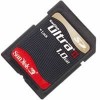SanDisk SDSDH-1024 Product Manual - Page 62
Relation between ACMD6 and Lock/Unlock State
 |
UPC - 710348911073
View all SanDisk SDSDH-1024 manuals
Add to My Manuals
Save this manual to your list of manuals |
Page 62 highlights
Revision 2.2 Chapter 4 - SD Card Protocol Description SanDisk SD Card Product Manual 4.4.8 Table 4-7 Force Erase Function to Locked Card CMD42 Parameter PWP14 Bit3 Bit2 Bit1 Bit0 1 0 0 0 Yes TWP15 GWP16 Don't care Result of the Function Error17 Card Status Bit25 Bit24 1 1 1 0 0 0 No Yes Execute force erase & clear 1 to 0 0 Temporary Write Protect and Group Write Protect18 1 0 0 0 No No Execute force erase 1 to 0 0 • Relation between ACMD6 and Lock/Unlock State ACMD6 is rejected when the card is locked and bus width can be changed only when the card is unlocked. Figure 4-11 shows the relation between ACMD6 and Lock / Unlock state. Table 4-8 Relationship between ACMD6 and Lock/Unlock State Card State Bus Mode Result of the Function Unlocked 1-bit ACMD6 is accepted Locked 1-bit ACMD6 is rejected and remains in 1-bit mode Unlocked 4-bit ACMD6 is accepted Locked 4-bit ACMD6 is rejected and remains in 4-bit mode; CMD0 changes to 1-bit mode Note: After power on (in 1-bit mode), if the card is locked, the SD mode host shall issue CMD42 in 1-bit mode. If the card is locked in 4-bit mode, the SD mode host shall issue CMD42 in 4-bit mode. • Commands Accepted for Locked Card The locked card will accept commands listed below and return a response with setting CARD_IS_LOCKED. − Basic class (0) − Lock card class (7) − CMD16 − ACMD41 All other commands (including security commands) are treated as illegal commands. Note: After power on, the host can recognize the card lock/unlock state by the CARD_IS_LOCKED in the response of CMD7 or CMD13. Application-specific Commands The SanDisk SD Card is defined to be protocol-forward-compatible to the MultiMediaCard Standard. The SD Card system is designed to provide a standard interface for a variety application types. In order to keep future compatibility to the MultiMediaCard standard together with 14 Write Protection PWP: Permanent Write Protect (CSD bit13). 15 Write Protection TWP: Temporary Write Protect (CSD bit12). 16 Write Protection GWP: Group Write Protect (CMD28, CMD29, CMD30). 17 Refer to Note 2 in Table 4-6. 18 Refer to Note 3 in Table 4-6. © 2004 SanDisk Corporation 4-18 12/08/04















